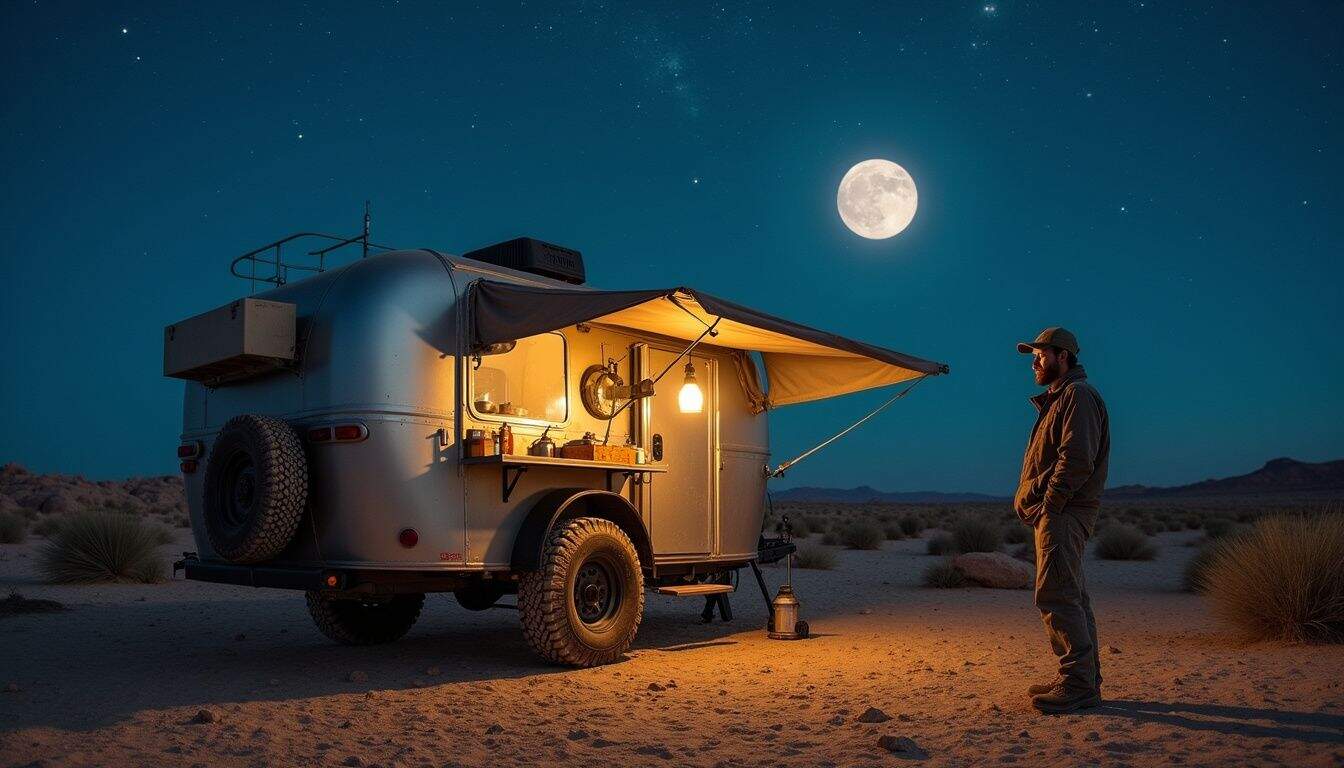Planning a vacation can be hard when you want comfort and travel to wild places. Vacationing with an off-road trailer lets you reach remote spots, while still enjoying essentials like a kitchen or wet bath.
This blog will show you top tips, key features, top camper trailer brands, and must-see destinations for your next trip. Get ready to discover why camper trailers make outdoor adventures easy and fun.
Key Takeaways
Off-road trailers help you travel to remote places like Moab, Utah and the Colorado Rockies. Brands such as Opus OP 15 Hybrid and Bruder EXP-6 are made for rough trails and wild weather.
Models like Boreas Campers EOS-12 cost around $74,990 and have up to 20 inches of ground clearance. The Kimberley Kampers Kruiser T-Class starts at $178,581 with strong tires and easy towing under 1,340 pounds dry weight.
Good features include all-terrain tires, solar panels (up to 300 watts), water tanks (up to 40 gallons), smart storage (like Sasquatch’s 90 cubic feet), strong frames with steel or aluminum parts, air conditioning, and heating.
Choose the right trailer by checking your route using apps like Gaia GPS or AllTrails. Always research local weather with AccuWeather or NOAA before heading out—especially since some areas flood in summer or close early from snow.
Popular trailer types are teardrop campers for singles/couples; pop-up campers that sleep five; hybrids with full kitchens for families; expedition models with rooftop tents for long trips. Renting first helps pick what fits your needs best before buying.
Table of Contents
Why Choose an Off-Road Trailer for Your Vacation
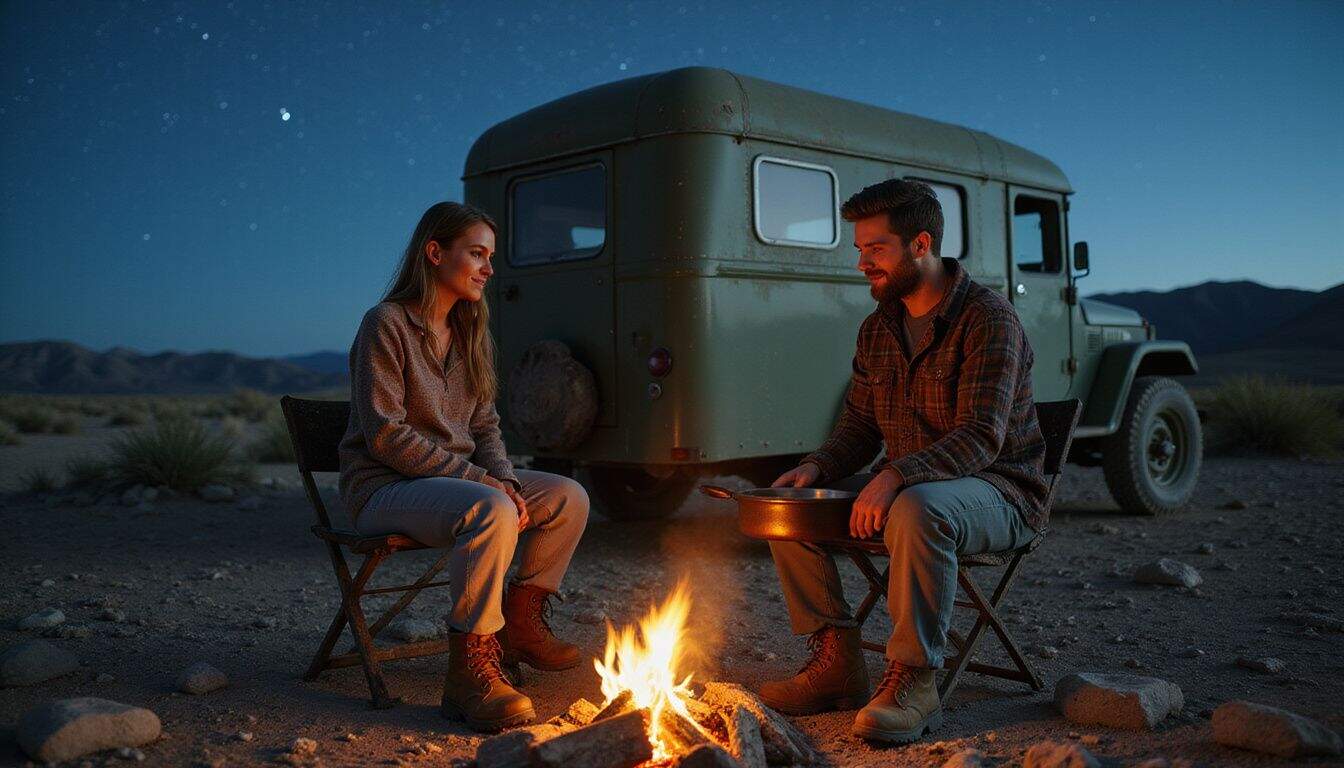
An off-road trailer lets you use a hitch and all-terrain tires to travel past where most motor-homes or travel trailers can go—no fancy RV park needed. You get more time in your cabin, outdoor kitchen, or under your rooftop rack, with the comfort of four-season capability always close by.
Flexibility and Freedom
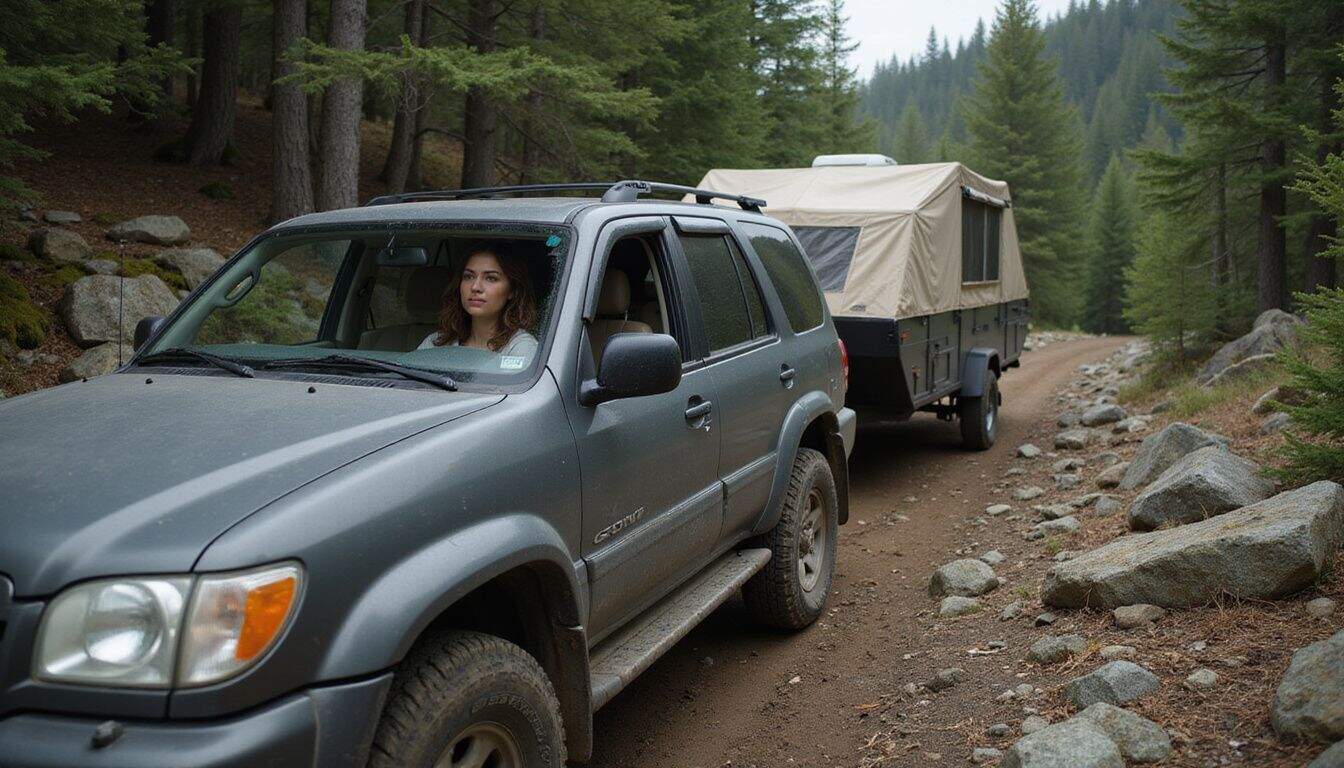
Choose any route, skip crowded campgrounds, and stop where you like. Towing an off road trailer lets you carry racks for bikes or rooftop tents. Use a pintle hook or hitch to attach your cabin; tow with automatic transmission vehicles if needed.
Pop-up trailers stay light, fitting many cars and SUVs without struggle.
Try camping on rocky paths that motor-homes cannot access. Reach remote spots using all-terrain tires and strong suspension over rough tracks or long wheelbase trails. The outdoor kitchen helps cook fresh meals anywhere—no need for busy parks or city stops.
Renting before buying allows women to select size, features, wheels, fridge setups, climate controls, storage space—even four-season capability—to fit personal needs. Explore new locations freely with an off road trailer instead of sticking to old travel routines.
Accessing hidden campsites is possible with tough builds designed for both rain and sun. Next: learn how these trailers bring comfort outdoors wherever the destination leads.
Access to Remote Locations
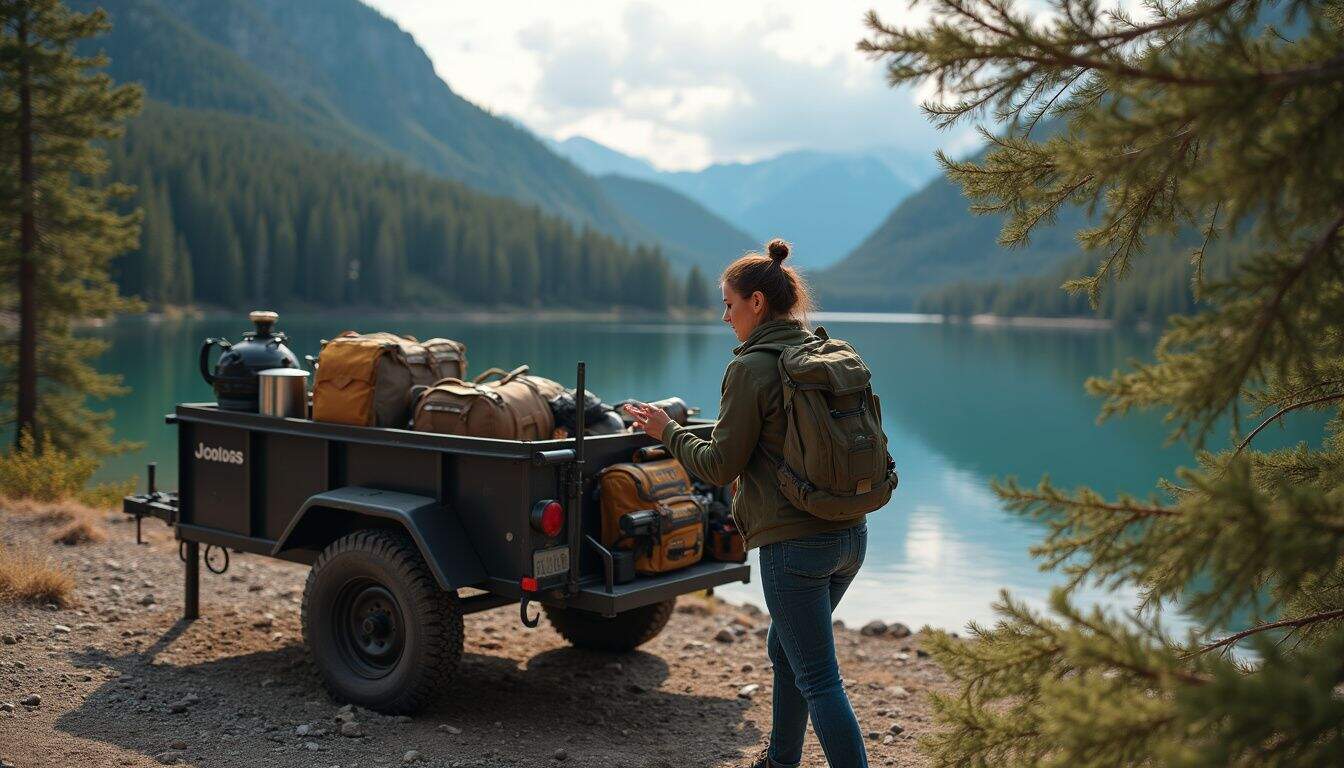
Off-road trailers reach places that big caravans cannot access. They travel across mud, rock, and sand with ease. Models like the Vorsheer XOC or TetonX offer better access to remote spots due to tough design and compact size.
Pop-up campers weigh less. Lighter weight means higher fuel efficiency on rough roads where gas stations are far apart.
“Explore hidden lakes and mountain trails—your trailer goes where your car leads.”
Tailgating at secluded sites gets easier because off-road trailers hold more gear in their ample storage spaces, freeing up your tow vehicle for people or extra supplies. Renting these trailers first helps test what works for you before buying one; many women choose this method before picking a favorite style for frequent off-roading adventures.
Enhanced Comfort in the Outdoors
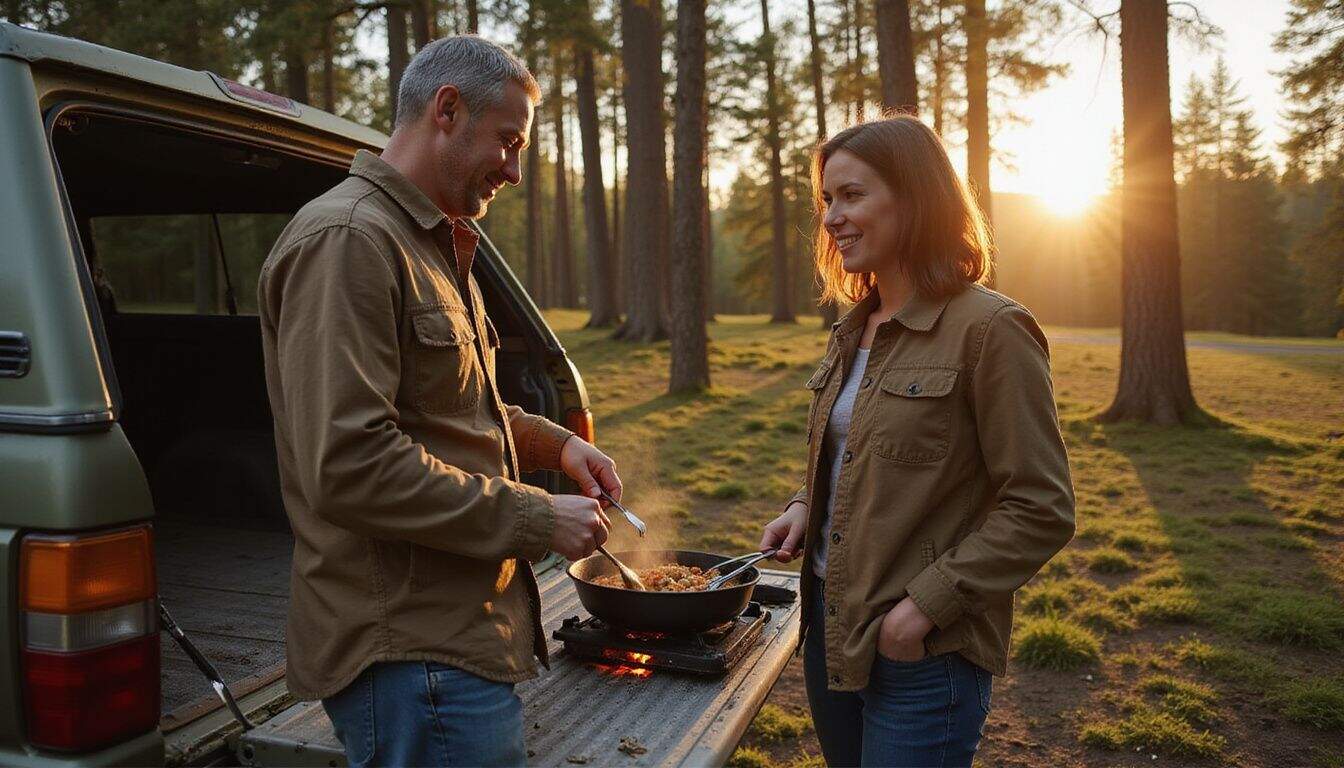
Built-in amenities like beds, kitchens, and climate control make camping easy. Models such as pop-up campers save fuel yet provide a soft place to sleep at night. Many trailers include water tanks and power systems for showers and lights.
You can access remote areas without leaving comfort behind.
Popular off-road trailers pack gear in storage bins instead of crowding your tow vehicle near the rear axle. Teardrop campers or expedition models stay stable thanks to strong suspension and all-terrain tires that handle extra vehicle weight and rough ground.
Most have tailgate cooking setups plus throttle pedals for simple use if you need quick meals outside.
Set up camp with less stress using these smart designs; you do not need piles of extra equipment or worry about brakes failing on backroads. See more family travel tips before heading out solo or together—your email address gets you updates and deals from many brands too.
Types of Off-Road Trailers
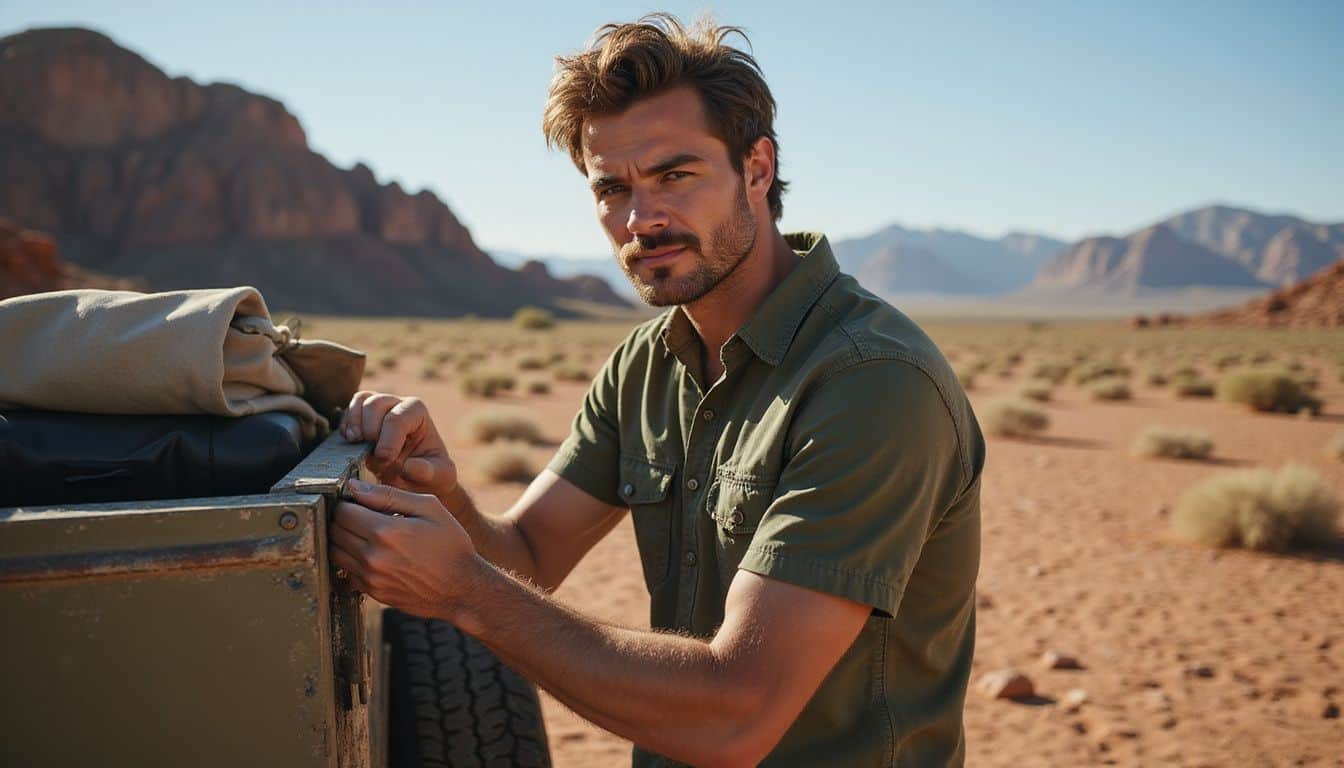
Off-road trailers come in different shapes and sizes, made for rugged trips. Each trailer type fits unique needs—some offer lightweight frames, while others have extra room or better off-grid gear.
Teardrop Trailers
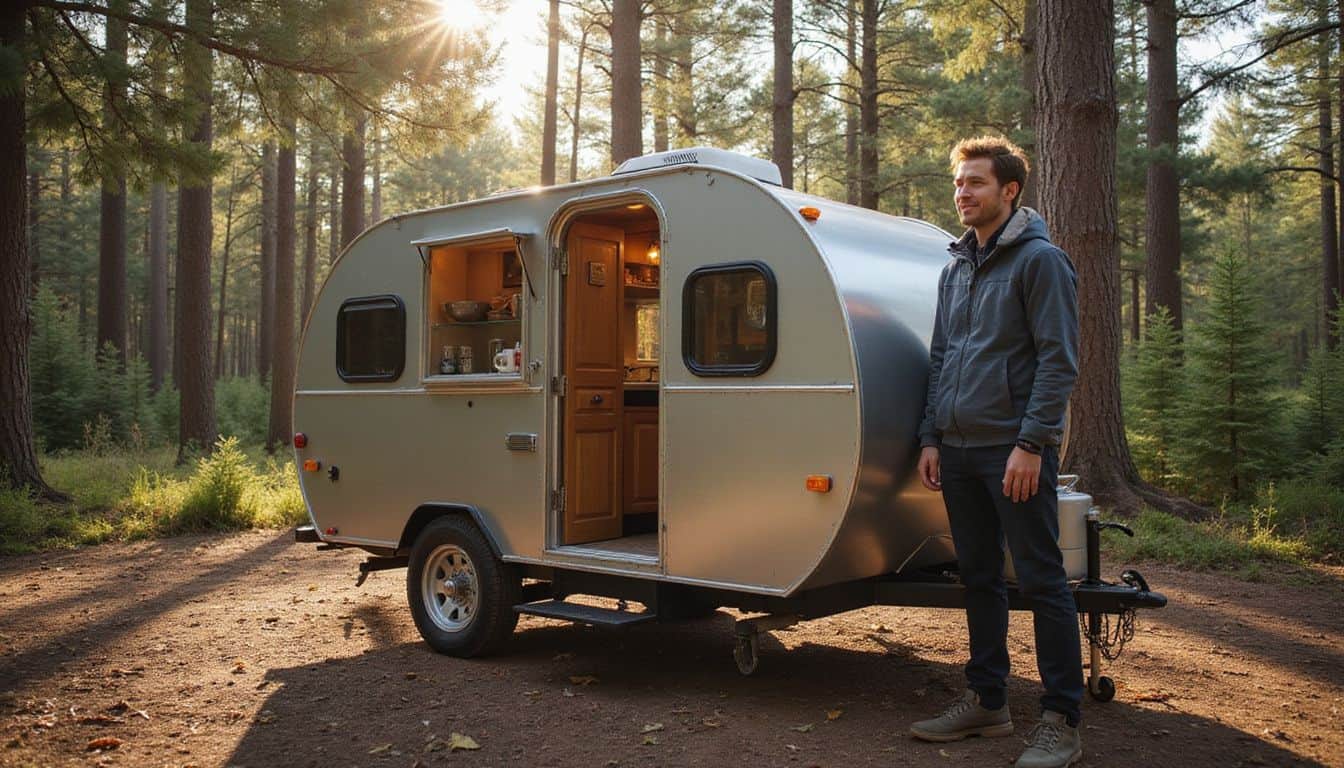
Teardrop trailers are small, enclosed campers best for solo trips or couples. Each trailer includes a cozy sleeping area and a rear kitchen space. Most models weigh under 2,000 pounds, so you can tow them with many SUVs or crossovers.
Their lightweight build helps you reach off-grid camping spots without trouble.
Manufacturers use tough materials like aluminum frames and reinforced panels for durability outside city roads. With built-in beds and kitchens, packing gets easier and faster each time you plan your trip.
Many national parks restrict larger RVs; teardrop trailers fit well in smaller sites at places such as Moab or the Smoky Mountains. Renting one first lets you find out what features meet your needs before buying.
Pop-Up Campers
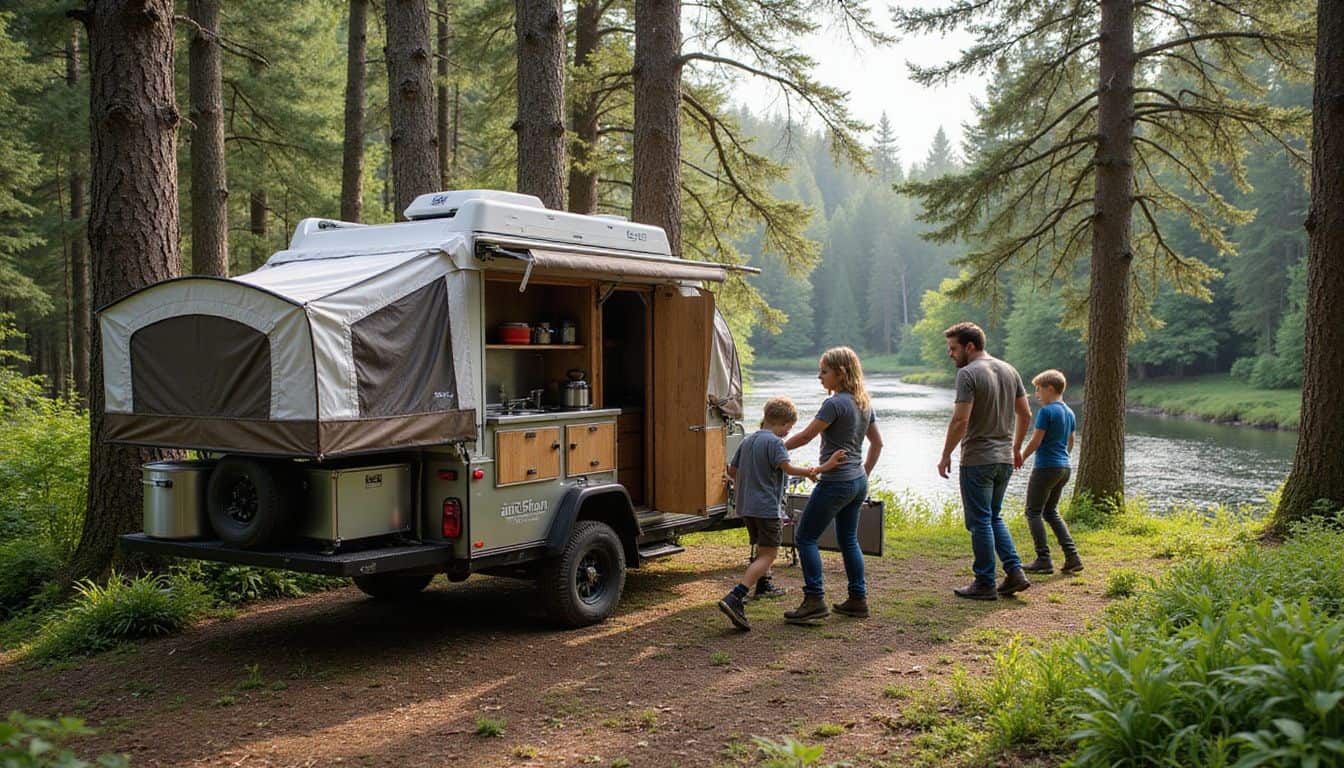
Teardrop trailers work well for solo camping or couples, but many women need more space and flexibility. Pop-up campers like the AntiShanty AS-1 Limited or Arkto Campers G12 offer that extra room without getting too heavy.
These pop-up models weigh less than full-size RVs, so you can tow them to rough places with smaller SUVs or trucks.
You get real sleeping comfort since some units sleep up to five people. Setup takes longer compared to hard-sided trailers. Built-in kitchens and storage cut down on packing gear into your car.
Thin canvas walls make insulation tough in very cold or hot weather; some brands may tear if scraped by branches on narrow trails. Still, most pop-ups reach quiet sites no giant trailer could enter—perfect for friends or families who want nature close but not too rugged.
Camping is easier with amenities inside your trailer—even better when you save time packing.
For group trips and practical gift ideas, check out my gift recommendations for travelling couples.
Hybrid Trailers
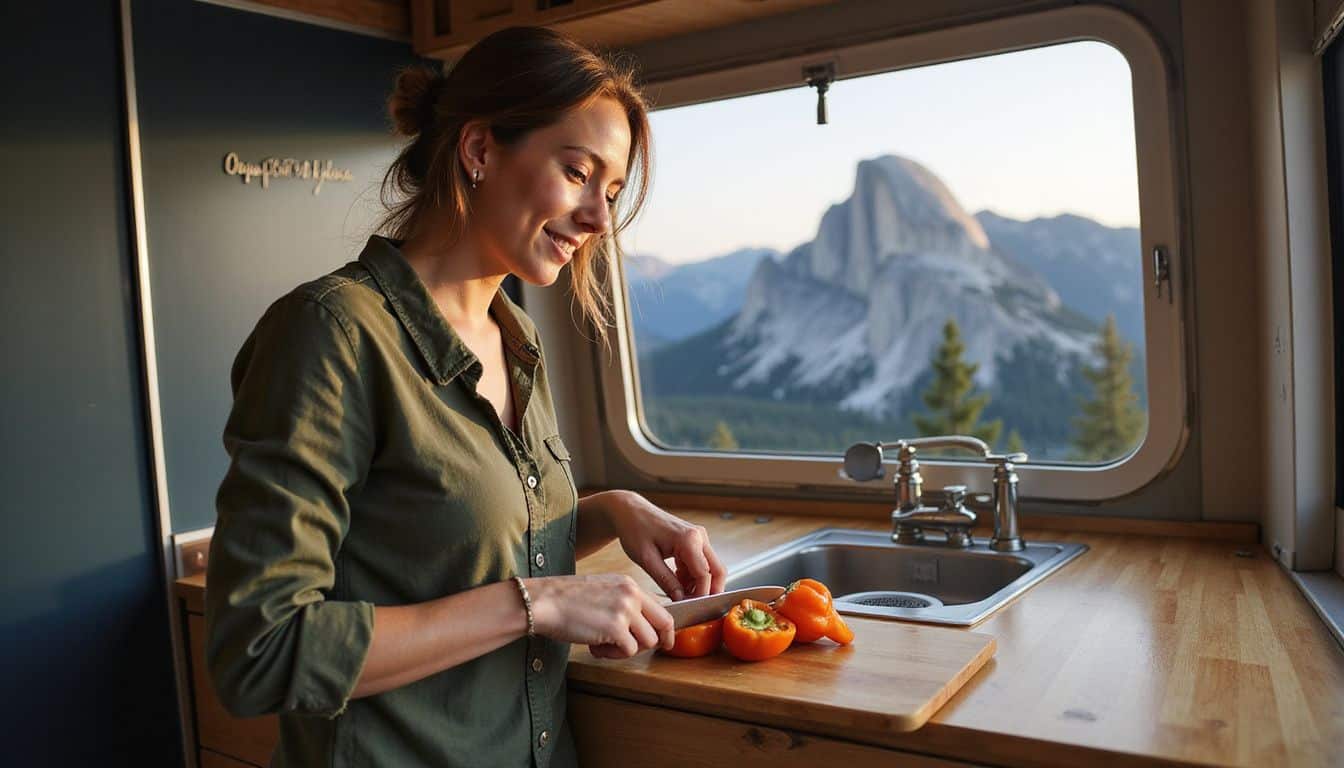
Hybrid trailers combine off-road mobility with better comfort for families. The Opus OP 15 Hybrid offers a kitchen, dining area, and sleeping space for up to four people. Families can cook, eat, and sleep inside this trailer on rough ground or in remote areas.
These trailers give you more room than teardrop campers while staying easy to tow.
Examples like the Opus OP 15 Hybrid have hard walls; they keep out wind, rain, and bugs. You can use solar panels or built-in water tanks on some hybrid models for extra support in wild places.
Many women pick hybrids because they balance toughness with features that feel like home.
Expedition Trailers
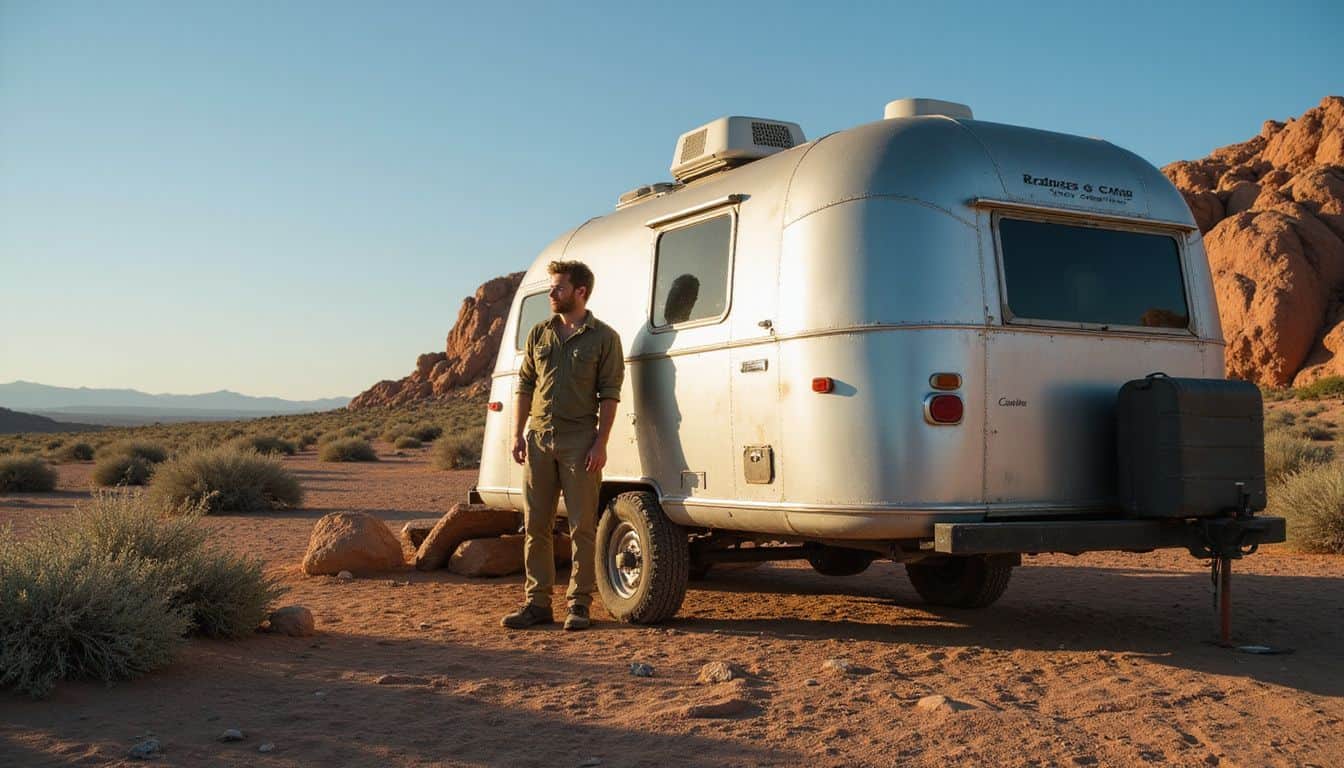
Expedition trailers handle rough trails with ease. These campers use strong steel frames and reinforced panels. Their weight can reach 3,500 pounds or more. They often include rooftop tents, slide-out kitchens, and water tanks up to 30 gallons.
You will see solar power units on many models too.
Families can haul gear for days in their roomy storage bins. Examples are Turtleback Expedition Series and Patriot Campers X1H. People pick them for cross-country trips or week-long camping in wild areas.
Next, explore what features matter most when picking any off-road trailer style.
Features to Look for in an Off-Road Trailer
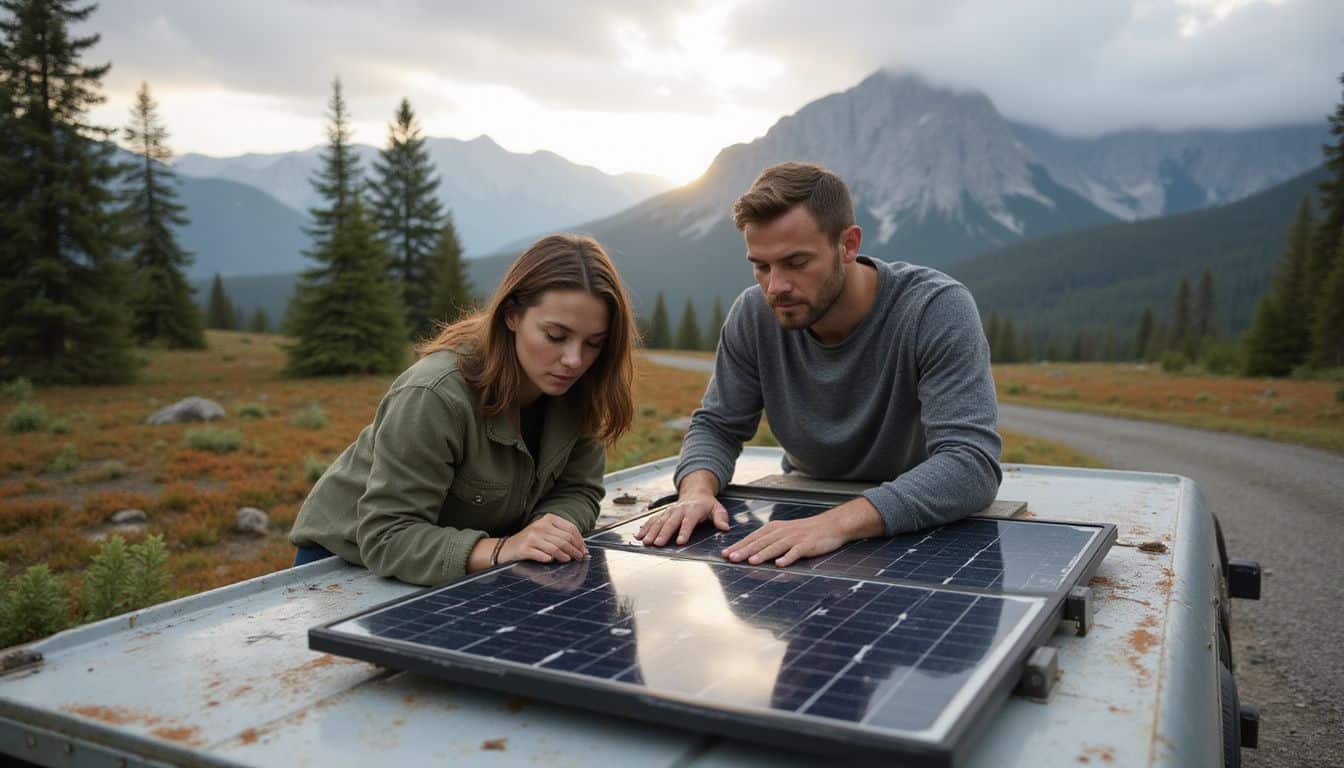
Strong gear keeps you safe and comfortable—every feature counts, from the frame to the wheels. Good equipment like solar panels or battery packs can make your trip easier…so get ready for easy camping anywhere you go.
Durable Build and Suspension

A strong frame and secure suspension keep an off-road trailer safe on rough paths. The Patriot Campers TH730 uses advanced airbag systems, while the Vorsheer XOC offers axle-less independent suspension.
These features handle bumps and rocks better than standard setups. Independent trailing-arm suspension also boosts ground clearance; it lowers the risk of getting stuck.
Lightweight designs, such as pop-up trailers, make towing easier for smaller vehicles. A durable build gives peace of mind on rocky trails and muddy roads. Trailers with these features tackle tough terrain year after year without breaking down or wearing out quickly.
All-Terrain Tires
Thick all-terrain tires keep your trailer steady on rocks, mud, and sand. Deep treads grip dirt roads better than regular car tires. Flat-proof cores help on rough trails. “Tough tires stop you from getting stuck far from help.” Always check tire pressure before heading out.
Proper traction helps pop-up campers, teardrop trailers, and expedition models travel over gravel or loose soil without sliding or tipping. Next up is water and power systems—key things to consider for comfort in the wild.
Water and Power Systems
Off-road trailers use solar panels and battery systems to keep you powered off-grid. Many models include onboard water tanks, efficient plumbing, and 12-volt outlets for lights or devices.
These setups allow you to camp in remote spots without losing comfort. Bring portable water filters or purification bottles like LifeStraw or Sawyer Mini—these help ensure safe drinking water from rivers or lakes.
Popular brands such as Boreas Campers EOS-12 and Opus OP 15 Hybrid come with these power and water features as standard. Some larger hybrid trailers store up to 40 gallons of fresh water, enough for small families on weekend trips.
Solar setups often supply at least 100 watts; this is enough for basic needs like phone charging and LED lighting. Always check tank levels before heading out so you do not run dry while away from city resources.
Ample Storage Space
The Sasquatch Expedition Campers Smuggler gives you 90 cubic feet of storage. Use its aluminum sidebox cabinets and roof rack for stashing bags, coolers, or gear. The Opus OP 15 Hybrid trailer features a bamboo dresser and an integrated king-size bed with extra room under the mattress.
Patriot Campers TH730 has a 13.62-foot-long deck and eight tie-down points; you can haul large UTVs or several dirt bikes.
BRS OFFROAD PURSUIT and BRUDER EXP-6 models let you change sleeping spots to fit more clothes or food bins inside. The CONQUEROR UEV 490 comes with many storage compartments and fold-out beds that save space during long trips.
Pop-up campers usually stay small but still offer clever places to store items while making sleep space for up to five people.
Climate Control Options
Air conditioning and heating keep off-road trailers comfortable in every season. Many brands now use solar panels to power these systems, so you can stay cool or warm even far from hookups.
High-density foam insulation helps maintain the inside temperature, blocking heat during summer and cold during winter.
Double-walled walls in some models provide better thermal control. The Opus OP 15 Hybrid uses a pop-up roof for airflow and sunlight; open it on nice days for fresh air without losing privacy.
These upgrades give women reliable comfort outdoors, wherever they travel.
Top Off-Road Trailer Brands and Models
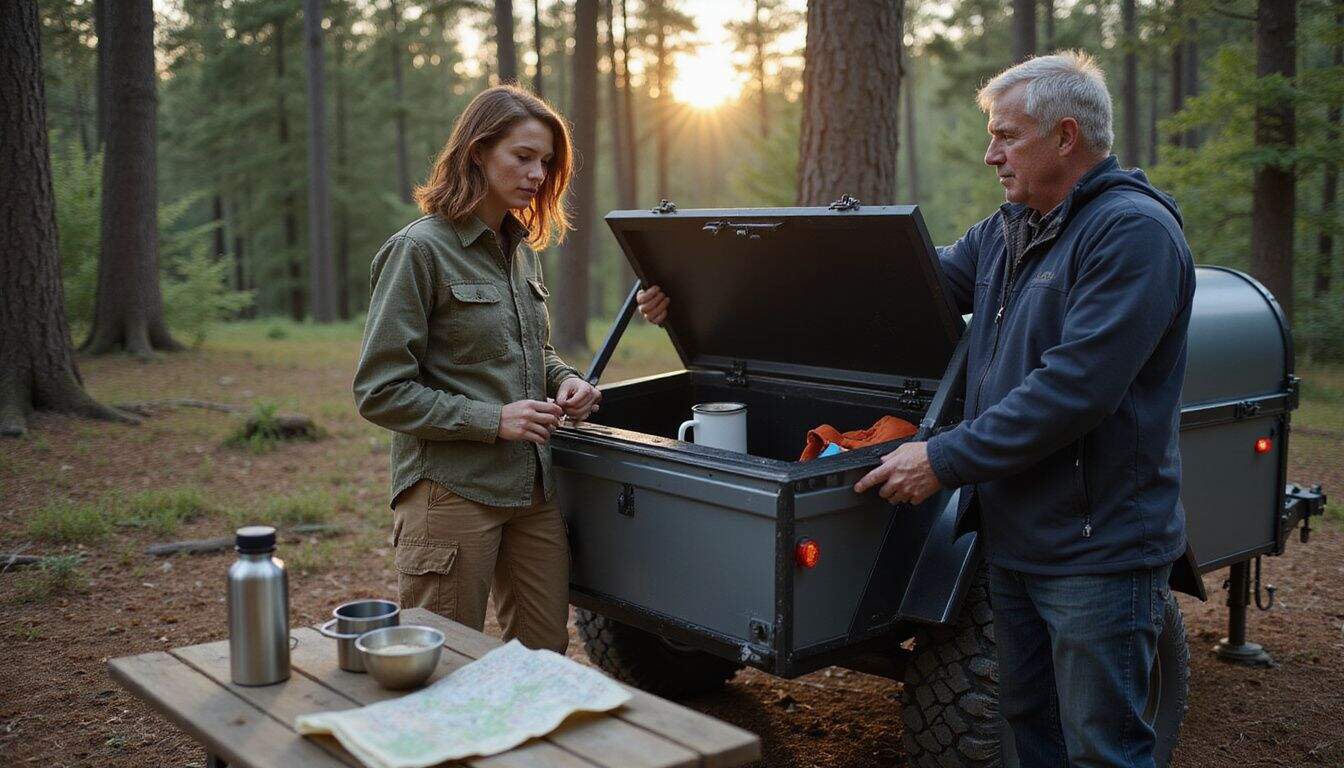
Many trusted trailer makers offer tough campers for off-road trips. Each company builds with strong frames, solid tires, and smart storage—perfect for rough trails and remote campsites.
Bruder EXP-6
Bruder EXP-6 fits up to six people and stands out among off-road camper trailers. It packs a slide-out kitchen, bathroom with shower and toilet, plus heating and air conditioning for comfort.
The trailer uses strong materials for rough tracks, so families can explore off-grid spots safely. Travelers enjoy advanced features like water systems, tough all-terrain tires, and climate control.
You will spot the Bruder EXP-6 among top brands such as Opus OP 15 Hybrid and Patriot Campers TH730. Families needing both comfort and true off-road ability find this model ideal along with examples like Taxa Cricket Overland.
For remote camping or cross-country trips through rocky trails, it delivers both luxury and durability in one package.
Boreas Campers EOS-12
Boreas Campers EOS-12 costs $74,990. It offers 20 inches of ground clearance, so you can drive on tough roads and rocky paths with confidence. You get a full kitchen outside the trailer, which has a three-burner cooktop, stainless-steel sink, and Truma fridge-freezer for easy meal prep.
This camper sleeps up to five people. The total weight stays under 4,000 pounds; most mid-size SUVs or pickups can tow it easily. The independent coilover suspension and 32.5-inch all-terrain tires give smooth travel over dirt or mud tracks in places like Utah’s backroads or Colorado mountain trails.
Conqueror UEV 490 stands out among off-road trailers for off-grid trips as well…
Conqueror UEV 490
Conqueror UEV 490 uses a military-inspired look that stands out in off-road settings. The frame mixes aluminum and galvanized steel to fight chipping and scratches, so bumps from rocks or trees do not cause damage easily.
I used the slide-out kitchen during my last mountain trip; it set up in seconds, kept things clean, and saved space inside.
The large outdoor shower area makes washing up simple after a long hike or day at the lake. It has both a pullout bed and a queen-size bed you can configure for how many need to sleep.
Features like air conditioning and a built-in media center mean families or friends stay cool, watch movies, listen to music, or charge phones without going back into town. UEV 490 is tough enough for remote campsites while staying fuel efficient on rough roads—similar to other pop-up trailers such as Opus OP 15 Hybrid and Patriot Campers TH730—for adventure travel far beyond paved highways.
Opus OP 15 Hybrid
Opus OP 15 Hybrid sleeps up to four people. It has a pop-up roof and an outdoor kitchen, making camping easy for families or groups of friends. The trailer rides on independent trailing-arm suspension and uses a 360-degree hitch for safer towing on rough ground.
A fully galvanized welded chassis keeps it strong across bumpy trails.
Three 100ah AGM batteries and one 300-watt solar panel let you stay off-grid for days without worry. Pack all your gear with its smart storage spaces inside and out. Many women find the simple setup time helpful after long drives; quick stops become stress-free breaks with cozy indoor space ready in minutes.
Test rentals can help you decide if this model fits your camping style before buying one new or used.
Kimberley Kampers Kruiser T-Class
Kimberley Kampers Kruiser T-Class costs $178,581. This trailer uses independent coilover suspension and strong 32.5-inch all-terrain tires for off-road use. It weighs about 1,340 pounds dry and measures almost 14 feet in length, so towing is simple with many SUVs or trucks.
The T-Class offers 90 cubic feet of storage inside and outside. The rear kitchen comes with an optional electric fridge or freezer to keep food fresh during long trips. A rooftop tent gives you a quick sleeping spot if you want to camp under the stars without fussing with extra gear.
This model fits outdoor adventures and suits families who need comfort while exploring remote places.
Next, check out planning tips for your own off-road trailer vacation.
Planning Your Off-Road Trailer Vacation
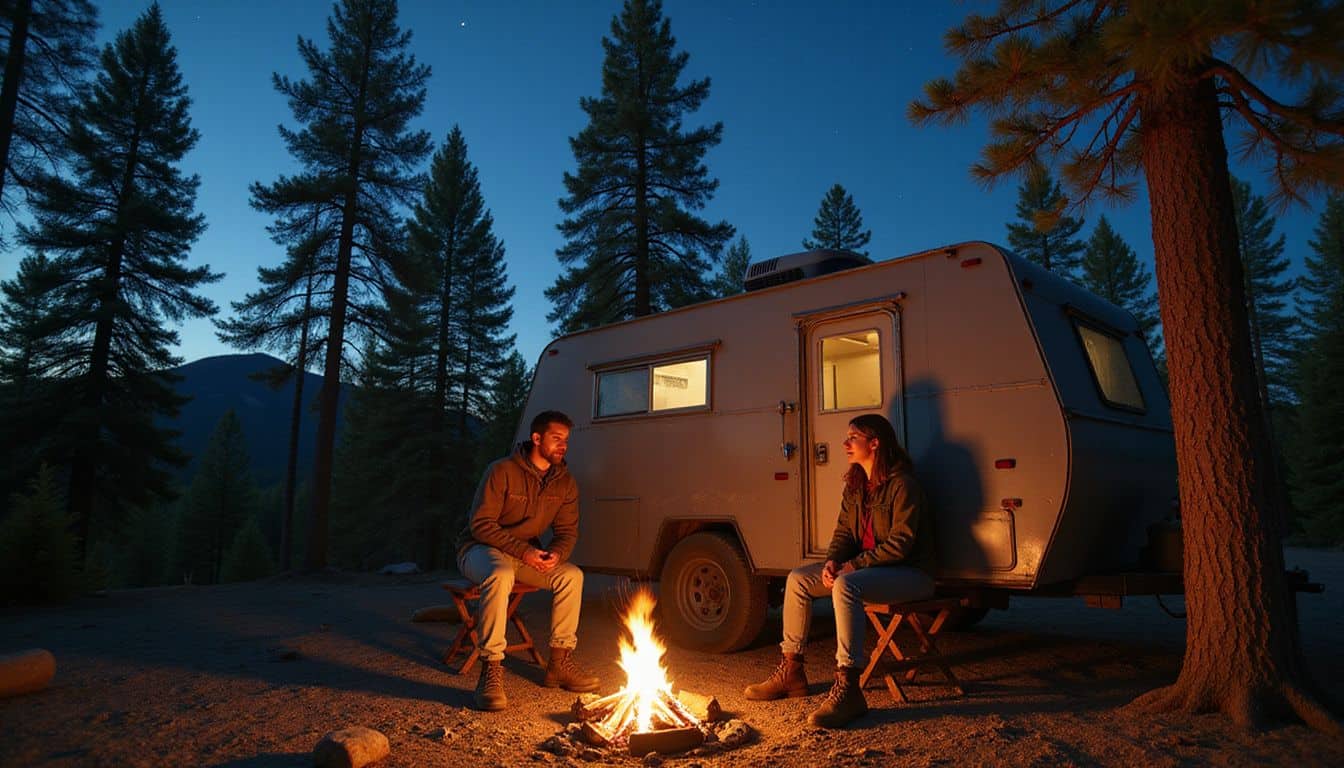
Planning helps you enjoy your trip, avoid stress, and save time. Use apps like AllTrails or Garmins off road GPS to track routes and find campsites with your off-road camper.
Choosing the Right Destination
Pick a spot that matches your trailer’s limits and route. Study the area, check if it fits your trailer’s type—like lightweight pop-up trailers work well for rough or narrow paths.
Look at places like the Continental Divide Trail or Baja California Sur; both offer unique routes for off-road travel lovers. Weigh towing capacity and terrain before you decide. Some sites need more ground clearance or tough tires, so always match those to your gear.
Choose from national parks and remote backroads in states such as Utah or California. Use maps to see if roads are open year-round, since some mountain passes close early due to snow.
Narrow down choices by checking how far you need to drive versus what supplies you can carry in storage spaces under 500 liters common with many expedition campers now sold in the US market.
Always choose practical over pretty views—getting stuck without enough traction will ruin any trip fast.
Researching Local Weather and Terrain
Check the local weather for your travel dates using apps like AccuWeather or NOAA. Heavy rain, snow, or heat waves can make some trails hard to use. Sudden storms may cause roads to wash out or campsites to flood.
For example, Moab gets flash floods in summer and up to 110-degree heat in July.
Review terrain maps with tools such as Google Maps Terrain or AllTrails before you go. Rocky areas need all-terrain tires and higher clearance trailers like the Opus OP 15 Hybrid. Soft ground after heavy rain may trap even large vehicles, so know the soil type and elevation changes along your route.
Clear facts about both weather and land help you choose the best trailer, plan safe routes, and stay comfortable at camp.
Mapping Out Campsites and Stops
Always use apps like Gaia GPS or Google Maps to save your camp locations. Mark 3 to 5 planned stops along the route; this helps with breaks and fuel top-ups. Many public lands, such as Bureau of Land Management areas, offer free camping—just search by county name or nearest city.
Rely on trail guides for update information about road closures. Save campground details offline—cell service will drop in remote spots. Confirm each stop has space for your off-road trailer before you go.
After mapping campsites and stops, study local weather patterns and the terrain at your destination.
Best Destinations for Off-Road Trailer Adventures
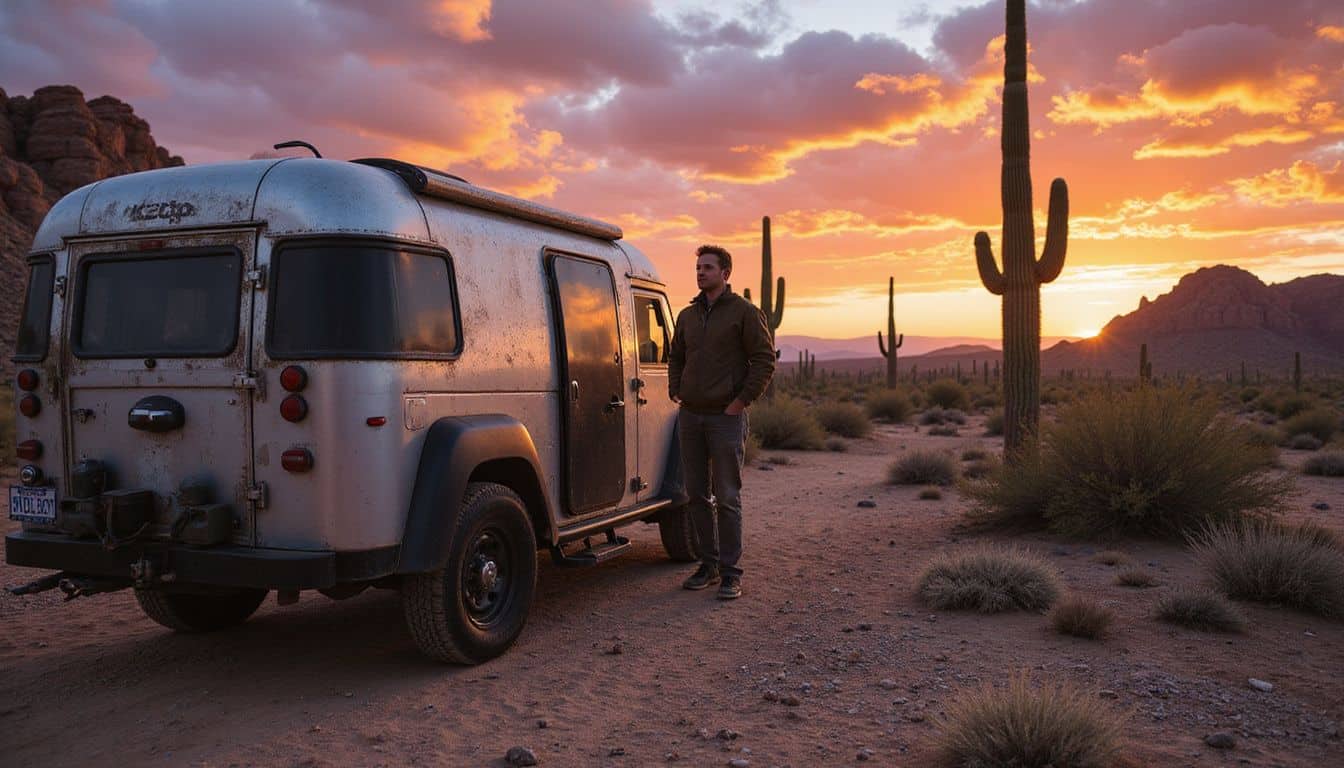
Off-road trailers take you to wild places, with trail systems and campgrounds waiting for you. Discover these top spots—bring binoculars, a camera, and your GPS unit to get the most from each trip.
Moab, Utah
Moab, Utah offers some of the roughest terrain for off-road trailer trips. This area has over 20 marked trails perfect for getting away from crowds. Drivers can explore places only a durable trailer can reach.
The Opus OP 15 Hybrid fits up to four people and handles rocky paths well.
Many trailers in Moab come with built-in showers, sleeping space, and cooking stations. Renting an off-road trailer here helps you try different models before buying one yourself. People love Moab for its real overlanding experiences and easy access to remote lands.
Each year, hundreds of women join groups or solo trips across this red rock region using these adventure-ready trailers.
Colorado Rockies
Moab, Utah draws many off-road fans, but the Colorado Rockies offer even more wild trails and high peaks. The Continental Divide Trail cuts through this mountain range, giving access to remote campsites only possible with an off-road trailer.
Off-road camper trailers like those from Mammoth Overland and MDC make setup easy in rocky or forested spots.
The Colorado Rockies stand as a top place for adventure travel with rough backroads and quiet valleys. Women enjoy enhanced comfort and safety by using durable brands built for these conditions.
An all-terrain trailer gives freedom to explore at your own pace while camping near clear lakes or alpine meadows. These trips give true flexibility, so you can relax far from crowds or lights any night of the week.
Great Smoky Mountains, Tennessee
Great Smoky Mountains National Park in Tennessee covers over 500,000 acres. The area draws off-road trailer fans with steep trails and wild views. Trails like Rich Mountain Road and Parson Branch Road test the limits of all-terrain tires and tough suspensions.
Reliable brands such as Bruder EXP-6 or Opus OP 15 Hybrid make trips safe across rocky paths.
Campgrounds support responsible camping with waste stations and clean water taps. Fluctuating fuel prices push more campers to pick efficient trailers for longer stays here. With so many creeks, valleys, pines, and open spaces, every trip feels unique.
I always pack a portable toilet system for better waste management after seeing how strict the rules are near Abrams Creek campground.
Joshua Tree National Park, California
Joshua Tree National Park covers 1,235 square miles and offers rough roads, rocky hills, and wide desert spaces. Off-road trailers like the Opus OP 15 Hybrid or Patriot Campers TH730 handle these trails well.
Many women use pop-up campers here for easy towing. These have low roofs, lighter frames, and better fuel use on steep paths.
You get built-in beds, kitchens, and showers so you stay comfy after long hikes among Joshua Trees or nights spotting stars. Travelers in forums say good off-road tires are key for sandy tracks near Barker Dam or Ryan Mountain.
To pick the best trailer model for your group size and comfort needs on tricky ground in Joshua Tree, check reviews by others who camped here; many mention saving space while keeping essentials at hand.
Check weather details before planning a trip to Rocky Mountains next.
Appalachian Trail, Virginia
The Appalachian Trail in Virginia offers over 550 miles of unique and rugged terrain, perfect for off-road trailer adventures. Many travelers prefer pop-up campers here due to their lightweight build and easy towing; these can fit into tight campsites along the Trail.
Some users report challenges with insulation and setup during cold or wet weather. Larger hard-sided trailers offer more comfort but are harder to tow on steep or narrow roads.
Preparing means knowing your vehicle’s towing limits before heading out. Renting a type of trailer first helps many people find what fits best for their needs along this route. Regular checks, DIY repairs, and basic maintenance ensure a smooth trip through the Appalachian mountains’ rough paths, especially when remote service is not available.
Preparing for Your Off-Road Adventure
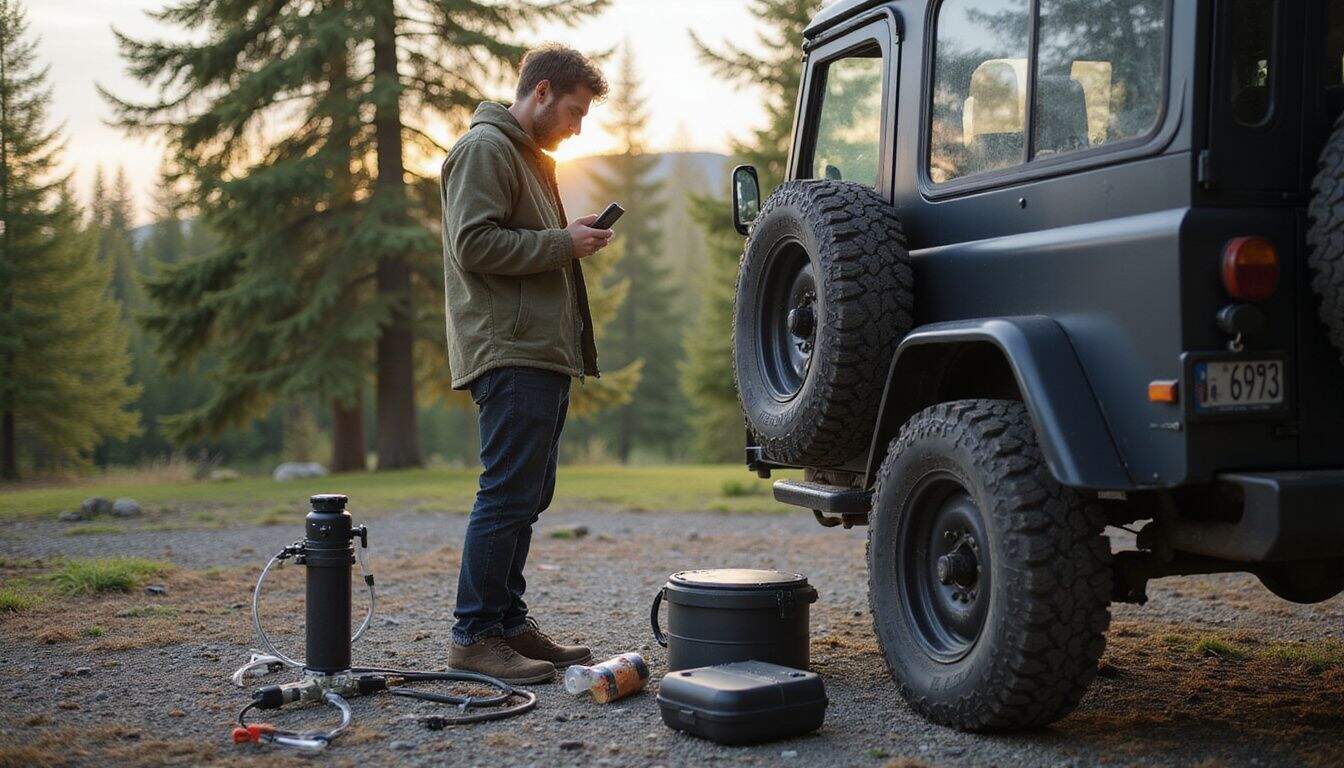
Get your off-road trailer ready with a thorough check using a simple inspection tool like a checklist app. Make sure you pack smart for comfort and safety—think water filters, tire inflator, portable battery, and outdoor gear from brands like Dometic or Goal Zero.
Packing Essentials
Pack light but cover all basics. Start with weatherproof clothes, sturdy shoes, and a hat. Carry a first aid kit, sunscreen, insect spray, flashlight, multitool, lighter or matches, and duct tape.
Use stackable containers to save space; bring 2 reusable water bottles for each person.
Add a compact stove or grill plus simple cookware like pots and utensils. Store dry food in sealed bags; keep perishables in a cooler with ice packs. Bring 2 towels per person—one for showering and one for outdoor use.
Include chargers or batteries for devices if your trailer supports power systems.
Never forget important items: driver’s license, insurance papers, spare tire kit with jack and wrench set. For waste disposal at remote campsites pack trash bags and biodegradable soap to wash dishes safely outdoors.
First-hand tip: Place heavier gear near the trailer axle to balance weight during bumpy rides. This makes towing easier over rough ground every single time you travel off-road.
Inspecting and Maintaining Your Trailer
Inspect every part of your off-road trailer before any trip. Check the suspension, brakes, and tires closely for signs of wear or damage. Look at joints and seals for leaks; address anything loose or cracked with basic tools like wrenches or screwdrivers.
Test all camping features including power systems, water tanks, kitchen stoves, and bathroom fixtures to make sure everything works as it should.
Weigh your loaded trailer to match towing limits on your SUV or truck. DIY repairs often solve small issues fast—tighten bolts, patch minor leaks, or replace fuses using kits found at hardware stores like Home Depot.
Regular checks keep trips safe and comfortable by reducing breakdown risks away from town services.
Understanding Towing Safety
Towing off-road puts stress on your SUV or truck. Always check the towing capacity shown by your car maker. For off-road trails, cut this number in half to stay safe. Pulling a teardrop trailer, pop-up camper, hybrid model, or expedition unit over rocks and mud needs extra care.
Choose trailers built for tough backroads like Bruder EXP-6 or Boreas Campers EOS-12. They are strong but still need checks before every drive. Know basic repairs—many owners fix flat tires or replace broken taillights themselves using tools such as wrenches and tire jacks.
Keep water tanks tight and brake lights working at all times; faulty parts can ruin trips into places like Moab or Joshua Tree National Park. Easy access to gear matters, since reaching storage bins beats unloading everything roadside during a quick fix.
Reliable routine maintenance keeps you moving forward without delay.
Benefits of Vacationing with an Off-Road Trailer
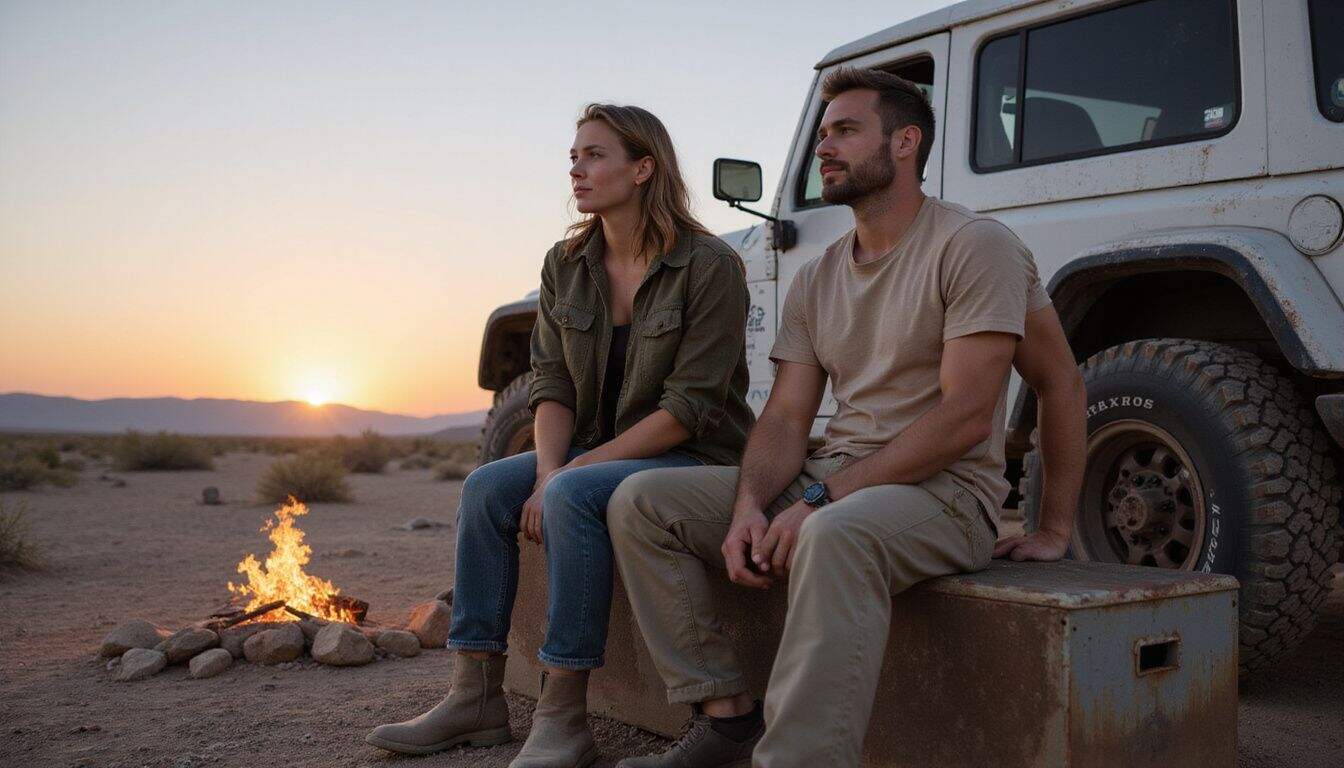
Off-road campers help you save money, enjoy wild spaces, and bring everyone closer—keep reading to find out how.
Budget-Friendly Travel
Staying at paid campgrounds costs much less than booking hotels. Bringing an off-road trailer lets you skip eating out at pricey restaurants; you cook your own meals using a propane stove or electric grill.
You also save money by avoiding high baggage fees, since all your gear rides with you in the trailer.
Traveling to free dispersed campsites on public lands saves hundreds each trip compared to RV parks. Daily expenses stay low, as you use solar panels for power and refill water tanks at no cost in many places.
Tools like Google Maps help find cheap fuel stops along your route.
Immersive Nature Experiences
Off-road camper trailers reach remote places where regular campers cannot go. Trails like the Continental Divide Trail offer wild views and quiet spots to set up camp. Many models include solar panels, water tanks, and off-grid power systems for longer stays outdoors.
Women can enjoy sunsets, animal sightings, or calm mornings with coffee in nature.
Rugged builds and all-terrain tires handle rocky paths without worry. Comfort amenities such as kitchens, beds, and storage space reduce packing stress by 30 percent compared to tents.
Renting a trailer gives a taste of outdoor life before buying one. Families often notice children spend more time outside exploring and less time on devices during these trips.
Family and Group-Friendly Options
Families and groups find built-in bathrooms, kitchens, and entertainment systems in models like BLACK SERIES HQ12 and BOREAS CAMPERS EOS-12. The Opus OP 15 Hybrid sleeps four people, with a dinette, full kitchen, plus separate beds for kids or friends.
Lightweight units from Vorsheer and Mammoth Overland fit families who need easy towing on rough trails. Water tanks, storage bins, and climate controls keep everyone comfortable at remote campsites.
Some trailers cut packing time by including gear lockers and power outlets for devices. Choosing the right trailer means checking your vehicle’s towing limit, along with thinking about road difficulty near campgrounds.
Families can pick options that allow quick setup once you reach your spot.
Next: Tips for First-Time Off-Road Trailer Travelers
Tips for First-Time Off-Road Trailer Travelers
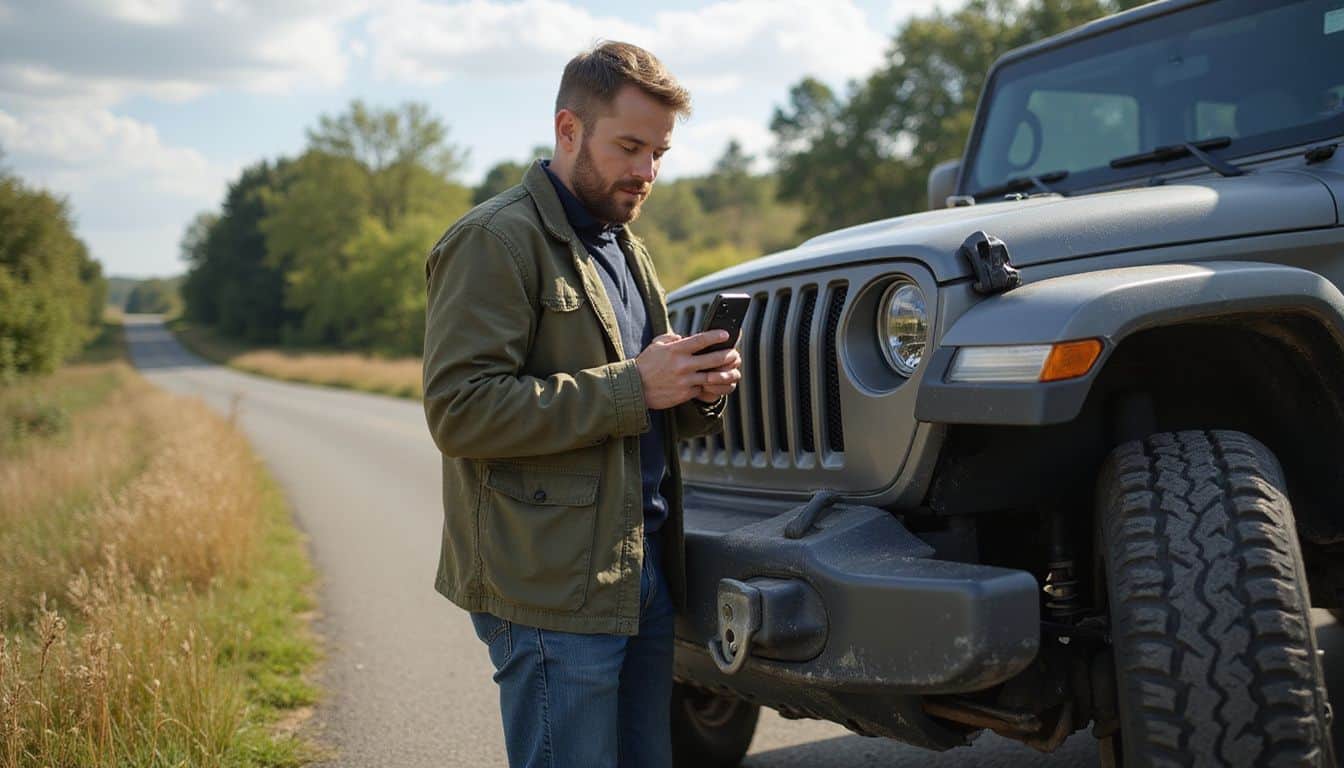
Test your Jeep or SUV with the trailer on quiet roads before hitting trails—this builds skill and confidence fast. Bring a toolkit, check hitches often, and use apps like Gaia GPS for safe route planning.
Start with Short Adventures
Start exploring with local off-road trails and nearby parks. Choose day trips or weekend getaways to learn how your trailer works in real conditions. Most women find short adventures help build skills fast.
Pack only what you need for 1 to 2 nights, then adjust for comfort and storage.
Take notes on which trailer features suit you best after each trip. Observe which locations are easy to reach, safe, and enjoyable for possible longer travel later on. As comfort grows with towing and camp setup, slowly lengthen trip time.
This method lets you gain confidence while staying close to home at first.
Practice Driving and Towing
Hook up your off-road trailer to your SUV or pickup. Practice driving in safe, open spaces like school parking lots or wide gravel roads. Try backing up and making sharp turns both left and right.
Use your mirrors often; they help you see blind spots behind the trailer.
Drive at different speeds between 10 and 40 mph while towing the camper. Test braking from slow and medium speeds so you know how much space it takes to stop safely with extra weight.
Make sure to practice going both uphill and downhill if possible, as this helps build confidence for real trails.
Learn basic maintenance next—know how to check tire pressure, tighten hitches, inspect lights, and spot leaks before heading onto rough ground.
Learn Basic Trailer Maintenance
After building skill with driving and towing, take time to learn trailer upkeep. Use a checklist for weekly tasks like checking roof seals and water heater anodes, especially before long trips.
Look at the trailer’s wheel hubs every 1,000 miles; grease or replace them if needed. Always confirm the trailer’s weight stays under its limit—never overload it.
Fix minor repairs yourself using simple tools such as socket wrenches and screwdrivers; learning DIY saves hours waiting for shops. Check waste tanks after each use—empty them at campgrounds with proper stations only.
Explore guides like TAP’s Ultimate Guide to find tips on selecting cleaning products and handling basic repairs fast. These steps ensure your off-road trailer remains safe and ready for new adventures every time you go out.
Challenges of Off-Road Trailer Vacations
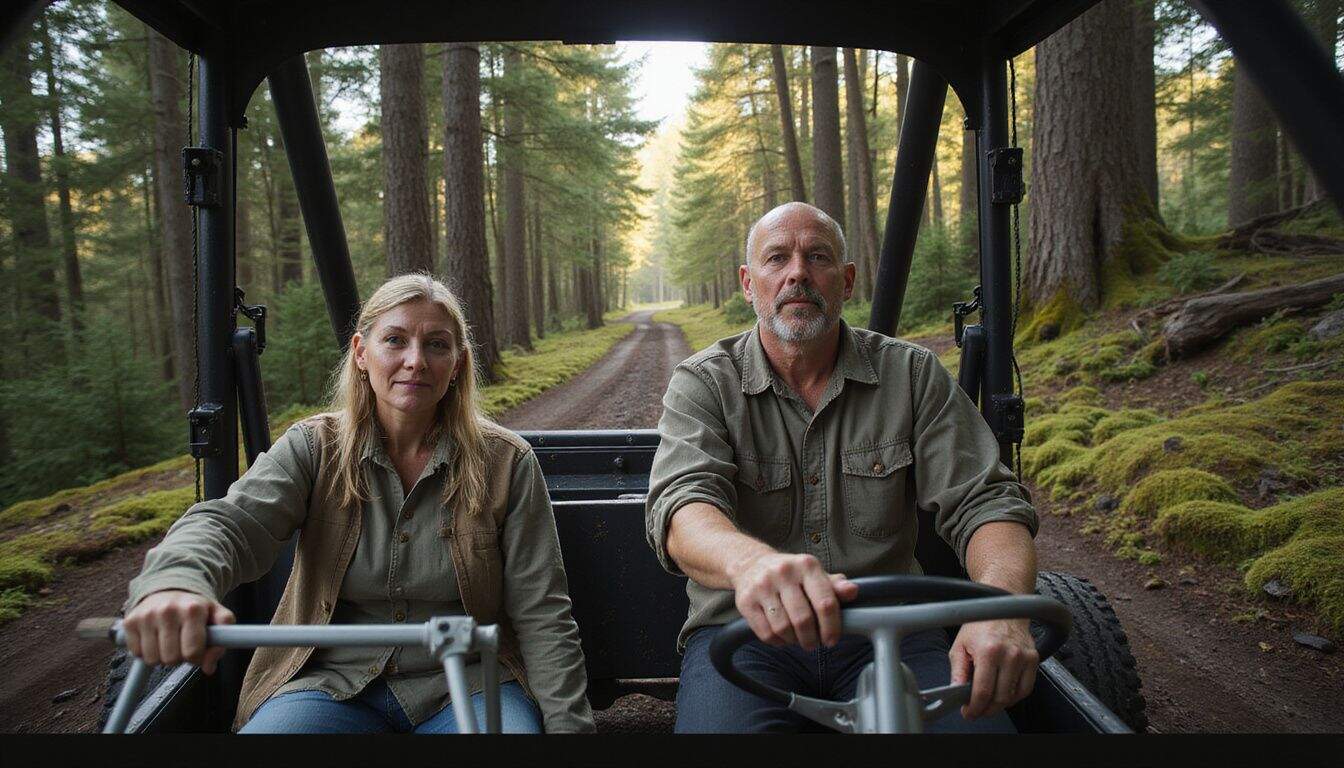
Rough roads and steep inclines can test your driving skills, especially with trailers like the Conqueror UEV 490 or Opus campers. Limited Wi-Fi and small living spaces mean you rely on GPS devices, offline maps, and smart packing to keep things simple.
Navigating Rough Terrain
Steep hills, loose rocks, and mud patches challenge even the best off-road trailers like the Bruder EXP-6 or Boreas Campers EOS-12. All-terrain tires and strong suspension keep your trip safe on these trails.
Dust often sneaks in through unsealed doors or vents; always check seals before heading out to stop this problem.
Setting up camp can take extra time if the ground is uneven. Pop-up campers save fuel but may let dust inside or feel cold at night without solid insulation. Renting a trailer first shows what works for you.
Basic DIY repair skills cut downtime if parts break while far from help—have tools ready, as I learned after fixing a snapped chain on my hybrid trailer last fall in Moab, Utah.
Limited Connectivity
Cell signals drop in remote places like the Colorado Rockies or Joshua Tree National Park. Expect texts and calls to fail, especially on dirt trails miles from towns. Most off-road trailers do not come with Wi-Fi or satellite internet.
Plan tasks like banking or emails before leaving strong service areas.
Offline GPS apps, paper maps, and walkie-talkies help when connections disappear. Bring backup power banks for phones since charging may be slower at campsites off the grid. Tech tools such as Garmin inReach messengers give SOS functions but need a sky view to work right.
Always share your trip plan with someone at home so they know where you are each day—safety comes first when going far off paved roads.
Space Management
Pop-up off-road trailers hold up to five people but need careful packing because of their lower rooflines and lighter weights. Sleeping space grows with tent-like set-ups, though amenities like fridges stay out of reach unless deployed.
Packing gear can get tricky inside these compact floor plans. Try renting different models first to see what size works for your group before buying. Always check the weight rating and frame strength; this matters most on rough roads or while towing over long distances.
Strong storage bins, cargo racks, and folding tables save space in small interiors. Prioritize multi-use items like collapsible cookware or stacking bins from brands such as Opus or Bruder EXP-6; these keep essentials tidy without crowding walkways.
Floor plans in expedition trailers focus on flexibility, yet pop-up campers might offer better headroom once expanded at campgrounds near Moab or the Great Smoky Mountains. Next comes a look at new trends like solar power systems and smarter designs that change how women camp outdoors.
Future Trends in Off-Road Trailers
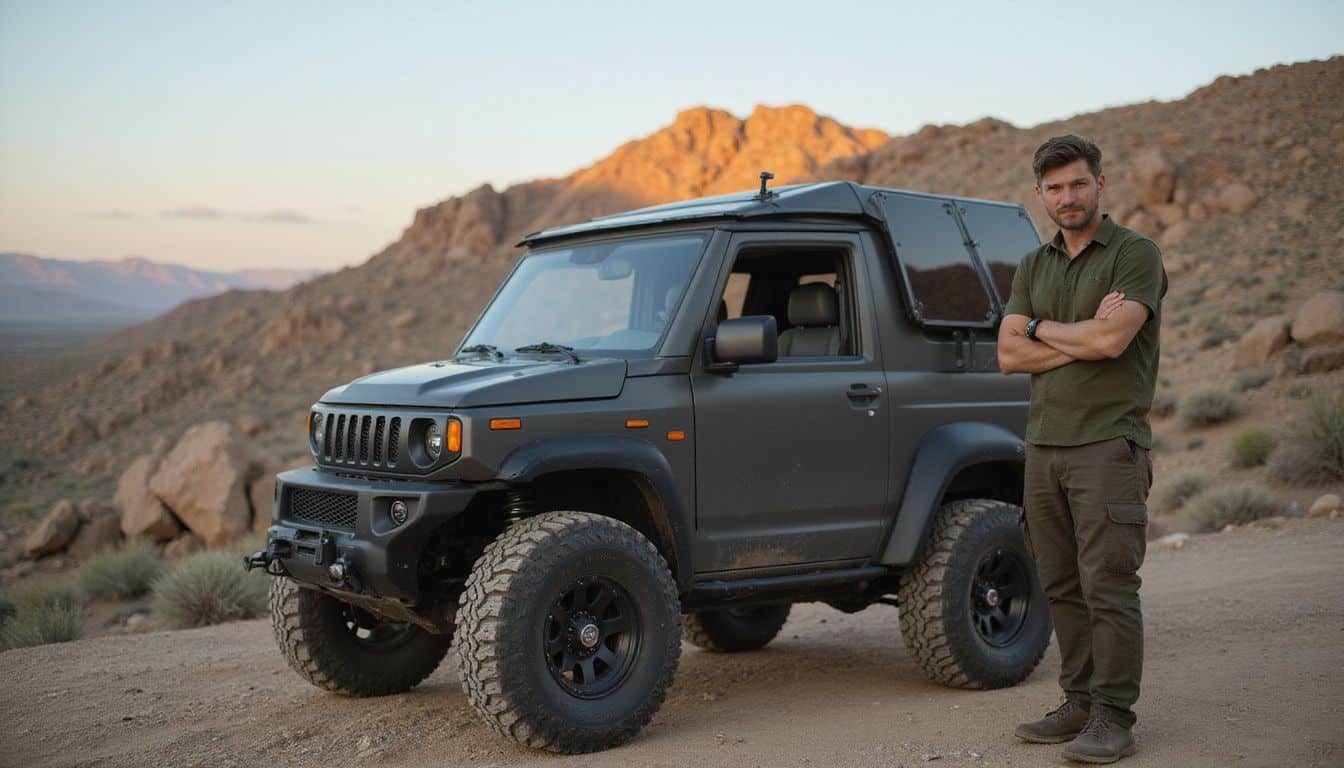
Future off-road trailers bring solar panels, lighter builds, and smart technology—keep reading to see what’s coming next.
Solar-Powered Systems
Solar-powered systems let you camp away from busy sites. Off-road trailers like the Opus OP 15 Hybrid use solar panels and batteries to run lights, fridges, and small appliances. The BLACK SERIES HQ12 and BOREAS CAMPERS EOS-12 also give strong off-grid power with their built-in solar setups.
BRS OFFROAD PURSUIT sets an example by adding renewable energy to its design. Many models from Off Grid Trailers now include solar options for true off-grid living. Camper sales have jumped since 2017, showing more people want clean camping solutions using solar technology.
Solar panels keep your trailer powered in remote places—no noisy gas generators needed.
Lightweight and Compact Designs
Pop-up campers and lightweight teardrop trailers make off-road travel easier. These models fit into narrow trails and tough spots. A pop-up trailer can sleep up to 5 people, so it’s great for family trips or groups of friends.
These units help save fuel because they are light.
Each compact camper uses energy-smart parts, like a 120Ah lithium battery that works for up to seven days. Buyers with smaller vehicles benefit from lighter options since towing is less stressful and safer.
Top brands, such as Boreas Campers EOS-12 and Opus OP 15 Hybrid, offer these features in their designs. With smart storage spaces and good airflow, these trailers keep you comfortable while saving space on every trip.
Smart Trailer Technology
Lightweight and compact designs make towing simple, but smart trailer technology takes comfort even further. New off-road trailers now include features that enhance both connectivity and ease.
Models like the Opus OP 15 Hybrid and Patriot Campers TH730 have integrated amenities like Bluetooth controls, remote power monitoring, and automatic leveling systems. In the VORSHEER XOC series, advanced independent suspension keeps rides steady over rocky ground while solar panels support off-grid living.
Travelers use mobile apps to check water or battery levels right from their phones. Even in remote spots without cell service, some systems offer GPS tracking for safety. Modern campers expect these upgrades to save time and add peace of mind during every trip.
Smart trailer technology meets these needs with clear results—stronger performance, less worry, more fun.
People Also Ask
What are the main benefits of vacationing with an off-road trailer?
Off-road trailers let you camp almost anywhere, far from crowds. They carry gear easily and protect it from weather. You get comfort and freedom to explore rough places.
Which destinations are best for off-road trailer trips?
National forests, desert trails, mountain passes, and remote lakes work well for off-road trailers. Look for public lands with dirt roads or rugged paths that allow camping.
What top tips help make an off-road trailer trip safe and fun?
Always check your route before leaving; plan fuel stops early. Pack light but bring recovery tools like shovels or traction boards in case you get stuck. Secure all items inside the trailer so nothing shifts on bumpy roads.
How do I choose the right off-road trailer for my needs?
Pick a model that matches your vehicle’s towing limit; lighter is often better on tough ground. Make sure it has strong tires, good suspension, and enough storage space for food, water, and gear needed at remote sites.
